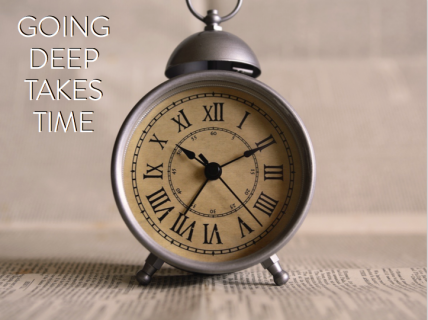RWDevCon 2016 Inspiration Talk – Going Deep by Ken Yarmosh
In this inspirational talk, Ken Yarmosh discusses strategies to arrange your work and life so that you have more opportunities to go deep in your work and create something really special. By Christine Sweigart.
Sign up/Sign in
With a free Kodeco account you can download source code, track your progress, bookmark, personalise your learner profile and more!
Create accountAlready a member of Kodeco? Sign in
Sign up/Sign in
With a free Kodeco account you can download source code, track your progress, bookmark, personalise your learner profile and more!
Create accountAlready a member of Kodeco? Sign in
Contents
RWDevCon 2016 Inspiration Talk – Going Deep by Ken Yarmosh
25 mins
- Transcript
- Some Examples Of Going Deep
- It Takes Time, But Is Worth The Investment
- Eight Things to Consider That Will Help You To Go Deep
- 1) Define Deep For You
- 2) Foster a Creative Environment
- 3) Be Present
- 4) Regulate “News” Intake
- 5) Now Versus Later
- 6) Use The Right Tools
- 7) Automate Whenever Possible
- 8) Allocate Deep Time
It Takes Time, But Is Worth The Investment
If you start to subscribe to this, and this sounds like an interesting concept, especially as we talk through this a little bit more, just realize that it does take time if you do this.
Again, you don’t wake up one day and just win an Apple Design Award. I saw Jeremy go through that process. I’ve known him for a long time now, and I can tell you those blog posts, all the things that he mentioned, it took a long time to get to that point and to where he is now.

If you go down this path, many habits have to be broken and retrained. Depending on research you look at, it could take 21-66 days to form a new habit, but then take the better part of a year to break some of your bad habits.
If you’re constantly going through your day and letting all these different notifications and all this different technology drive you, expect that it’s going to take some time to start really being able to go deep.
Eight Things to Consider That Will Help You To Go Deep
I want to talk with you now about eight different considerations for setting up your environment, your work, so that you can start doing these things.

It doesn’t mean that if you follow all these eight things, you’re going to win an Apple Design Award or create a library that every single person in the community’s going to use, but these are the kinds of traits and things that you’ll see out there for those who actually do go deep.
1) Define Deep For You
The first one ties in nicely actually to what Jamie talked about. If you think about “Why” being your higher level guiding principles, the next level is to think about what really matters most to you and what you want to accomplish, more specifically, in your goals.
A number of weeks ago, I got to hear a New York Times bestselling author. His name’s Lewis Hobbs. He talks about doing great work, and he wasn’t someone that started out this way. It’s, again, someone that just started on a journey, started a podcast, started having people listen to him. He talked about what he does.
One of the things he does is he frames his vision, literally. He takes it and hangs it up on his wall and he said, “This is going to be my certificate of achievement in the next 6-12 months.” He’s very, very specific. Something that we also heard earlier in another talk. This grounds him in the distraction-filled environment and this is the place that we need to think about.

We also took the time to do something similar to what Jamie talked about, tying these two things again together at Savvy Apps, called our Guiding Principles.
Why do we do this? So that we have the more tangible, quarterly or yearly goals, but we also have these things that help us that we can reflect back to on a regular basis. This is actually something that we’ve even published on our website.
2) Foster a Creative Environment
Having an inspiring work environment is another element that has a significant impact on going deep.
If you look across at the people who are the most creative, the most prolific, you often see they have these great environments, things that they keep around them to refer back to. It even talked about Lewis’ certificate of achievement that he puts up on his wall in his office.
But if you look at someone like Mark Twain, as an example, there is a really beautiful place that he got to work out of.
It’s one of his writing spots, a writing hut or writing gazebo. It had these beautiful scenic views and a very focused workspace, and it’s very likely, from what we know in history, that he probably wrote both Tom Sawyer and Huckleberry Finn in that spot specifically.

For us specifically at Savvy, it’s taken us a long time to get to this spot, but we now have a really fun work environment that we can feel proud to come into every single day.
We have very minimal kind of design. We have places where we can collaborate. We have places where people can work that’s not a traditional work spot.
I want you to think about this, even if you actually work at home or work in a shared space. It doesn’t mean it’s just only applicable to the office environment. If you work at home, make that an inspiring environment. Don’t have your personal bills laying around your desk. Don’t have laundry a couple of doors down. As you walk to the bathroom, you’ll see the laundry and think, “i’ve got to get to that later.” Think about this as it relates even to those kinds of environments.
Also, in the shared workspace. If you’re working out of a coffee shop or in a co-working spot, I’m sure it’s not distracting you. You need to be able to have a focused, inspiring environment when it comes to being able to set up to go deep.
3) Be Present
If you think about the creative, physical workspace as one part of it, another element of going deep is really your mental aspect of this. Being present for me is about focusing on those who are around me. It’s about focusing on my family members. It’s about focusing and allowing my mind to wander and to just be alone with my thoughts.
Believe it or not, it actually really starts with my iPhone, my mobile device. How many times now do you see people sitting somewhere and there on a public transportation, they’re just scrolling through everything. They’re crossing the street, they’re scrolling through everything. Everyone’s always checking something on their phone.
We’re all guilty of it. I won’t call you out if you’re doing it right now. It’s totally fine.

What I’ve done with my own mobile device is actually set it up so that I have no reason to want to grab my phone and check it. I don’t put any news apps on there. I don’t have social media things going on. I don’t have any work applications. I don’t have email hooked up to it.
It’s really just a communication device to some extent. I even have a lot of things muted. I have notifications turned off, especially for those special family threads that we’re all on. Some of them are not the ones that we can unsubscribe to unfortunately. Really what it comes down to is, I’m even on the weekends often putting my device away and just being present.
What happens when you do this? You let your mind recharge, refresh. You actually come back to work ready to really do work. Just generally speaking, I think I’ve overall felt more fulfilled and just even a lot of times gotten ideas that I might not have gotten if I was going on my device and playing with it.